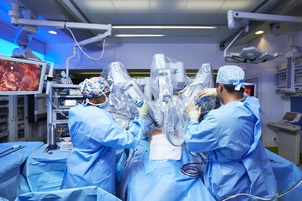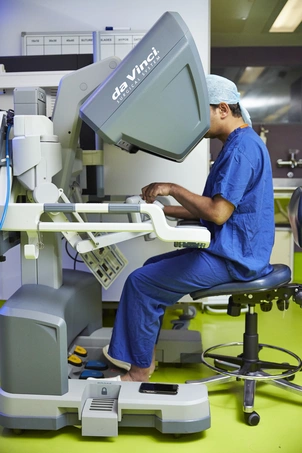
We spoke to Prof Prokar Dasgupta OBE, one of the world's leading robotic urological surgeons and Chair of our Centre of Excellence in Robotic Surgery. Prof Dasgupta is a pioneer of robotic surgery in the UK, and leads on surgical simulation, both nationally and internationally. He was appointed Officer of the Order of the British Empire (OBE) in the 2023 Birthday Honours for services to surgery and science.
Are TLC still a leader in terms of this using robotics in our practice, across different cancers?
The London Clinic has remained a leader in the field of robotics, remaining the first and most experienced team in the private sector. We have a dedicated Centre of Excellence in Robotic Surgery which is multidisciplinary, involving surgeons, anaesthetists, surgical care practitioners, specialist nurses and theatre management teams. At The London Clinic we currently have three different robots - the da Vinci, the AquaBeam for treatment of benign prostate hyperplasia, and the ExcelsiusGPS robot for spinal surgery.
What cancers can the da Vinci robot be used to operate on, is it just for urological conditions?
The da Vinci system has evolved over the last 20 years. Although robotic assisted radical prostatectomy for prostate cancer remains the leading operation, the da Vinci is being used for kidney and bladder cancers, gynaecological cancers, bowel cancer, lung cancer and even transoral surgery for cancers of the throat.
What are the main benefits of using the da Vinci robot for procedures, compared to traditional surgical approaches?
Robotic prostatectomy is used for cancer that is still localised within the prostate and hasn’t spread further. The da Vinci robot is renowned for its precision and minimally invasive approach, compared to laparoscopic and open surgery in terms of outcomes and recovery. For our patients, robotic assisted operations result in less blood loss, shorter hospital stays, more precise surgery (especially important when it comes to cancer), better cosmetic results and a quicker recovery period/ return to normal.
What kind of training do surgeons undergo to use robotic systems like da Vinci?
Surgeons undergo a period of electronic learning and then do what is a called a ‘dry lab’ which involves using stimulation software to virtually practice the various steps of a procedure. Then most often they will do a ‘wet lab’ practicing on a cadaver for example, for a more realistic hands on simulation.
But it’s not just about training the surgeon, we also ensure all other members of the multi-disciplinary team are well trained also, including our surgical care practitioners, anaesthetic and, nursing teams.
How does the da Vinci system ensure precision during complex procedures?
We use a method called "low pressure" where the gas inside the tummy is kept at a constant, low pressure during the surgical procedure, which helps our anaesthetists achieve better pain control for our patients.
While using the Da Vinci robot our surgical care practitioners use a state-of-the-art headset called MedithinQ which provides real-time 3D vision. The device is kinder on the neck than using a conventional 3D screen and improves their performance, providing enhanced vision and accuracy, ultimately leading to better patient outcomes.

What does the future hold for robotic surgery in prostate cancer?
The future of robotics is exciting, and is largely driven by artificial intelligence. There are two key elements to this: improving the efficiency of the robotic surgeries, and improving the outcomes for patients. In the robotics world da Vinci has been a market leader for over 20 years, but now there are around 50 other companies building and selling new surgical robots. These devices are becoming increasingly intelligent.
An exciting development that's happening in robotics is the introduction of surgical data science. We can record the entire operation and then using AI we can examine the different steps of the operation, and find opportunities to improve efficiency and remove roadblocks which affect the operation time. By improving efficiency, we reduce risk of complications, and improve patient outcomes.
What developments are you currently working on in your own practice and research?
In terms of research I am currently working on a trial with King’s College London called TIGERS (Touch and Image Guided Robotic Surgery) where I use AI guided 3D printing to create a multidimensional image of the patient’s prostate and its surrounding structures, which gives me increased precision to remove the cancer. Once the results of the trial come through, then we think it could become the standard of care.
Something innovative I’ve been working on in my practice at The London Clinic, is a technique called Saline-Assisted Fascial Exposure (SAFE). One of the primary concerns that men face when undergoing prostate cancer surgery is the potential loss of erections. This is because the nerve bundles responsible for erectile function run along both sides of the prostate gland and are susceptible to damage during surgery. In some cases, surgeons need to remove one or both nerve bundles to ensure the best chance of completely eliminating the cancer. Even when these nerves are preserved, they require time and patience to heal, as nerve tissue regenerates much more slowly than other structures in the body. To address this, I have adopted a new nerve-sparing technique called SAFE. This method involves using a fine needle to carefully inject saline into the layers between the nerve bundles and the prostate. The saline helps gently separate the nerve bundles from the prostate, reducing the risk of damage during surgery. This approach is simple, precise, and highly effective.
